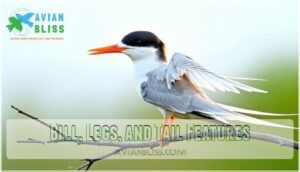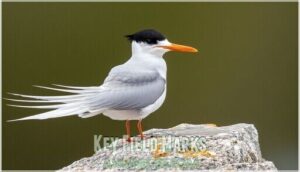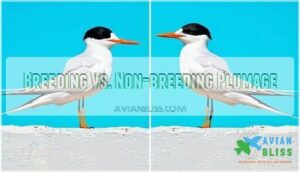This site is supported by our readers. We may earn a commission, at no cost to you, if you purchase through links.

This medium-sized seabird measures 13-14 inches long with silvery-gray wings that flash during flight.
During breeding season, it sports a crisp white body and black cap, while winter birds show distinctive black patches behind each eye instead of the full cap.
Forster’s terns prefer freshwater marshes and brackish wetlands, hovering gracefully before diving for fish with surgical precision.
Their bright orange-red legs and elegant streamers make them unmistakable once you know the telltale signs that separate them from their tern cousins.
Table Of Contents
- Key Takeaways
- Forster’s Tern Physical Description
- How to Identify a Forster’s Tern
- Habitat and Distribution
- Behavior, Diet, and Life Cycle
- Conservation Status and Threats
- Frequently Asked Questions (FAQs)
- How do you identify a forster’s tern?
- What is the difference between a Forster’s tern and a Caspian tern?
- What does a Forster tern look like?
- What is a Forster’s tern?
- Where do Forster’s terns live?
- Are Forster’s terns migratory?
- What is the difference between a common tern and a forster?
- Who is Forster’s tern named after?
- What is the habitat of the Forster’s tern?
- What do they look like?
- Conclusion
Key Takeaways
- You’ll identify Forster’s terns by their orange bill with a black tip and distinctive black eye patches in winter – these field marks separate them from similar species like Common Terns
- Look for them in freshwater marshes during the breeding season and in coastal areas in winter – they’re the only medium-sized tern commonly seen along shorelines during the colder months
- Watch for their elegant diving technique as they hover before plunging for fish with surgical precision – their silvery-gray wings flash during these graceful hunting displays
- You can distinguish breeding adults by their crisp white bodies and black caps, while winter birds show the telltale black patches behind each eye – this seasonal plumage change is key for year-round identification
Forster’s Tern Physical Description
You’ll recognize a Forster’s Tern by its elegant, slender build and distinctive size that falls between a Black Tern and Bonaparte’s Gull.
This medium-sized seabird measures 13-14 inches long with a 31-inch wingspan, displaying the characteristic long, deeply forked tail that extends past its wings when perched, which is a key feature of the Forster’s Tern.
Size and Measurements
How big is a Forster’s Tern compared to other birds? You’ll find this medium-sized tern measures 13-14.2 inches long with a 30.7-31.5 inch wingspan.
Both sexes weigh 4.6-6.7 ounces, showing no sexual dimorphism in measurement accuracy.
These comparative sizes place Forster’s Terns between Black Terns and Bonaparte’s Gulls, making bird identification easier through wingspan range and weight variation observations.
Plumage and Coloration
You’ll notice the Forster’s tern’s plumage stages reveal distinct color patterns perfect for bird identification.
This species displays remarkable seasonal transformations that make field marks easier to spot.
Key plumage features include:
- Breeding adults: Crisp white bodies with pale silvery-gray backs and wings
- Winter plumage: White crowns with distinctive black patches behind each eye
- Color variations: Minimal regional differences across North American populations
- Aberrant plumages: Rare but documented in some individuals.
The feather structure creates flashing silvery wings during flight, helping you distinguish this species from similar terns.
Bill, Legs, and Tail Features
You’ll recognize Forster’s Tern by its distinctive orange bill with black tip during breeding season.
The bird’s short legs appear bright orange-red, perfectly adapted for perching rather than wading.
Long tail streamers extend well beyond the wings when perched, creating an elegant silhouette.
These bill adaptations and leg morphology help distinguish it from similar species.
| Feature | Breeding Season | Non-breeding Season |
|---|---|---|
| Bill Coloration | Orange with black tip | Mostly black |
| Leg Function | Bright orange-red | Duller red-brown |
| Tail Streamers | Deeply forked, long | Shorter, less pronounced |
| Overall Shape | Pointed bill, short legs | Same basic structure |
Seasonal and Age Variations
Forster’s terns undergo dramatic plumage changes throughout their seasonal birding calendar and breeding cycle.
Winter adaptations strip away the distinctive black cap, leaving only a characteristic black eye patch for age determination.
During juvenile molting, young birds display brownish mottling and shorter tail streamers compared to adults.
These seasonal transformations in forsters tern behavior and bird plumage help birders track bird migration patterns and identify individuals across different life stages throughout the year.
The related arctic tern’s migration spans both hemispheres annually, showcasing an impressive example of bird migration.
How to Identify a Forster’s Tern
You’ll find Forster’s Tern identification becomes easier once you know their distinctive features. Look for their black eye patch in winter and orange bill with black tip during breeding season.
Key Field Marks
Spotting a Forster’s tern in the field becomes easier when you know what to look for. These elegant seabirds display distinct characteristics that’ll help you confidently identify them among other tern species.
- Black eye patches – Winter plumage features distinctive dark marks behind each eye
- Orange bill with black tip – Breeding adults show this colorful bill coloration pattern
- Deeply forked tail – Long tail streamers extend past wing tips when perched
- Silvery-gray wings – Pale upper wing surfaces contrast beautifully with white underparts
Understanding tern identification nuances is essential for accurate spotting.
Breeding Vs. Non-breeding Plumage
Dramatic transformations occur between seasons as these tern species undergo seasonal molting.
During breeding season, you’ll spot vibrant orange bills with black tips and bright orange legs. The striking black cap creates a bold contrast against white plumage.
Non-breeding birds show completely different bill coloration – becoming mostly black – while leg coloration fades to dull reddish-brown. The distinctive eye patch replaces the breeding cap, making bird identification easier during winter months, and the change in plumage is a notable aspect of their seasonal molting.
Differences From Common and Caspian Terns
Comparing these tern species reveals clearer identification.
Forster’s Tern showcases whiter underparts than Common Tern’s gray chest, while Caspian Tern dwarfs both with its massive blood-red bill.
Size comparison reveals Forster’s medium build versus Caspian’s gull-like bulk.
Bill coloration differs dramatically—orange-tipped black for Forster’s, thin red for Common, thick crimson for Caspian.
Vocalizations and flight patterns provide additional distinguishing features between these seabird species.
Adult Forster’s terns have distinct breeding plumage with a black cap and nape, and their massive blood-red bill is a notable feature, while whiter underparts and orange-tipped black bill coloration are key identifiers.
Juvenile and Immature Identification
Young Forsters Tern birds break free from adult perfection with their rebellious mottled plumage and shorter tail streamers.
You’ll spot brownish markings across their wings, darker primaries than adults, and bill coloration that shifts from juvenile black to eventual orange.
These wing patterns and developing features make your bird identification guide complete for every age, including observations of rebellious mottled plumage and the shift to eventual orange bill coloration.
Habitat and Distribution
Understanding where Forster’s Terns live and travel helps you know when and where to spot these elegant birds.
You’ll find them in different habitats throughout the year, from inland marshes during breeding season to coastal waters in winter.
Preferred Breeding Habitats
You’ll find Forster’s Terns choosing freshwater and brackish wetlands with dense marsh vegetation for their breeding grounds.
They need water depths between 30-100 centimeters and prefer areas with cattails and bulrushes.
They build nests on floating platforms or muskrat lodges, forming colonies that can exceed 50 pairs per hectare in prime habitat.
Wintering Grounds
When breeding season ends, Forster’s Terns set out on impressive journeys to their wintering grounds.
You’ll find them along warm coastlines where food remains abundant year-round.
Climate impacts and habitat selection drive these migration patterns, with Sterna forsteri populations concentrating in productive coastal waters.
Key wintering locations include:
- California’s Pacific coast and inland waters
- Atlantic shores from New Jersey southward
- Gulf of Mexico coastlines extending to Central America
These bird migration routes follow food availability, leading flocks to estuaries, bays, and saltwater marshes.
Their coastal distribution during winter months makes them North America’s only medium-sized tern commonly seen along shorelines.
Geographic range shifts dramatically as they abandon inland breeding territories for marine environments rich with small fish and aquatic prey.
Geographic Range in North America
Forster’s Terns have spread their wings across North America’s vast geographic range, from breeding locations scattered throughout inland wetlands to coastal wintering grounds.
You’ll find Sterna forsteri nesting in the Nearctic region, primarily around Great Lakes and midwestern marshes.
During winter distribution, they migrate to California’s coast, Atlantic shores south of New Jersey, Gulf of Mexico regions, and even Central America, showcasing remarkable range expansion across diverse habitats.
Habitat Requirements for Nesting and Foraging
You’ll want to look for wetlands with plenty of Marsh Vegetation and shallow Water Depth.
Terns prefer nesting platforms like Muskrat houses or reed beds, keeping foraging distance short.
Habitat Connectivity is key—linked wetlands make bird foraging behavior easier.
Good tern habitat means open water, scattered vegetation, and safe sites for tern nesting.
Healthy bird habitat supports thriving populations.
Consider the role of thriving wetland plants in maintaining these ecosystems with Habitat Connectivity and healthy environments.
Behavior, Diet, and Life Cycle
You’ll discover that Forster’s Terns are skilled hunters with fascinating social behaviors and complex breeding rituals.
These elegant birds combine precise fishing techniques with strong family bonds, making them one of North America’s most interesting marsh-dwelling species, with strong family bonds being a key aspect of their behavior.
Feeding Habits and Techniques
With graceful precision, Forster’s Terns master the art of aquatic hunting through specialized tern foraging behavior. These piscivore birds demonstrate remarkable foraging ecology adaptations.
Key tern behavior feeding techniques include:
- Surface-dipping – skimming prey without wetting plumage
- Plunge-diving in shallow waters for fish capture
- Aerial hawking of insects above marsh vegetation
- Prey selection focusing 90% on small fish like silversides
- Diet variation includes opportunistic scavenging during scarce periods
Their diving techniques target the upper water column, while bird feeding habits show males primarily provision mates and chicks. They primarily inhabit freshwater and saltwater marshes during breeding and migration.
Kleptoparasitism rarely occurs, as these efficient hunters prefer independent foraging within 6 kilometers of colonies.
Social and Migratory Behavior
These social birds break away from solitary habits during migration and winter months.
You’ll spot them in loose flocks along migration routes, following coastlines and major waterways.
Their flocking dynamics shift seasonally—pairs scatter during breeding but reunite in groups for winter roosting.
Bird migration patterns take them from inland marshes to coastal areas where cooperative hunting becomes common.
A keen sense of smell also helps them locate food sources.
Social hierarchy emerges in winter roosts where experienced adults lead younger birds to prime feeding spots.
Breeding and Nesting Patterns
During breeding season, you’ll find these birds forming loose breeding colonies in large freshwater marshes.
Colony site selection focuses on areas with extensive cattail growth and muskrat houses that provide stable nesting platforms.
Each pair constructs simple nests using available nesting materials like dried vegetation.
Bird breeding research shows clutch size typically contains 2-4 eggs with an incubation period lasting 23-25 days.
Chick development occurs rapidly in these protected marsh environments, with a focus on rapid growth.
Courtship and Parental Care
Before male Forster’s Terns commit to breeding, courtship rituals include aerial displays and fish gifting to potential mates.
You’ll witness males presenting fresh catches to females, strengthening pair bonds through this behavior.
Once paired, both parents share nest defense duties, aggressively protecting their territory from intruders.
Chick development requires intensive parental roles, with adults taking turns feeding and guarding their offspring until fledging.
Conservation Status and Threats
While Forster’s Terns aren’t globally threatened, they face serious challenges in many regions where wetland loss has dramatically reduced their breeding habitat.
You’ll find this species listed as endangered in Wisconsin and Illinois, with special concern status in several other states due to ongoing threats from habitat destruction and human disturbance.
Population Trends and Global Status
You’ll find Forster’s Tern populations face mixed fortunes across North America.
Forster’s Terns thrive in western wetlands but struggle where habitat loss threatens traditional nesting sites
While core breeding areas remain stable since 1991, concerning trends emerge elsewhere.
Current Sterna forsteri bird population trends show:
- Global status: 80,000-100,000 mature individuals (Least Concern)
- Breeding success: 30% population decline in some Gulf Coast colonies (2000-2022)
- Conservation efforts: Protected under Migratory Bird Treaty Act
Bird conservation status varies regionally—this bird species thrives in western wetlands but struggles where habitat impacts and climate effects threaten traditional nesting sites.
These impacts contribute to habitat loss and fragmentation.
Threats to Survival
Multiple challenges threaten Sterna forsteri populations across North America.
North America’s elegant marsh hunters face mounting survival pressures from habitat loss and human interference
Habitat loss devastates breeding grounds as over 47% of historic wetlands disappeared to development and agriculture.
Climate impacts worsen through sea-level rise, increased storms, and drought cycles that flood nests or dry essential marshes.
Pollution effects harm reproduction when mercury and PCBs accumulate in eggs, reducing hatch success.
Human disturbance from recreational boating causes nest abandonment, while invasive species like carp destroy vegetation that provides nesting platforms.
Conservation Actions and Protections
Forster’s Terns benefit from thorough bird conservation efforts including Legal Protections under the Migratory Bird Treaty Act.
Population Monitoring tracks breeding success while Habitat Restoration projects enhance nesting sites.
Wetland Management programs create suitable environments for seabird conservation, and Public Awareness campaigns educate communities about bird species protection, which are part of the coordinated habitat conservation initiatives.
These coordinated habitat conservation initiatives provide hope for recovering populations across their range.
Importance of Wetland Preservation
Wetlands serve as nature’s kidneys, filtering pollutants while providing essential ecosystem services that benefit both Sterna forsteri and human communities.
These important habitats support biodiversity and endangered species conservation through interconnected processes.
- Water Quality: Wetlands naturally filter contaminants, maintaining clean water for terns and surrounding ecosystems
- Flood Control: Marshes absorb excess water during storms, protecting coastal communities from flooding damage
- Climate Regulation: Wetland vegetation stores carbon dioxide, helping mitigate climate change impacts on bird conservation efforts
Frequently Asked Questions (FAQs)
How do you identify a forster’s tern?
Look for a medium-sized white tern with a black cap, deeply forked tail, and orange bill with black tip during breeding season.
In winter, it shows a distinctive black eye patch instead of the full cap.
What is the difference between a Forster’s tern and a Caspian tern?
Size isn’t everything when identifying birds, but with these two species, it’s your biggest clue.
Forster’s Terns are smaller than Caspian Terns, with a much more slender bill, narrower wings, and a deeply forked tail.
The bill is coral red with a dusky tip on Caspians versus Forster’s orange bills.
What does a Forster tern look like?
You’ll spot this elegant seabird by its slender build, deeply forked tail, and distinctive black eye patch in winter plumage.
It’s medium-sized with silvery-gray wings, white body, and orange legs during breeding season.
What is a Forster’s tern?
Like a silver arrow dancing through marsh reeds, you’ll discover a Forster’s Tern—a medium-sized seabird with elegant white plumage, pale gray wings, and distinctive black eye patches that transform seasonally between coastal and freshwater habitats.
Where do Forster’s terns live?
You’ll find Forster’s terns breeding in North American inland marshes and wetlands, particularly around the Great Lakes and Midwest.
During winter, they migrate to coastal areas from California to Central America and Gulf coasts.
Are Forster’s terns migratory?
Like restless wanderers following ancient pathways, you’ll discover that Forster’s Terns are indeed migratory birds.
These elegant seabirds breed in North America’s inland marshes during summer, then journey to coastal wintering grounds from California to Central America, which makes them a fascinating example of seabirds.
What is the difference between a common tern and a forster?
You’ll notice Forster’s Terns have orange bills with black tips and distinctive black eye patches in winter.
While Common Terns show red bills and black caps extending to their eyes year-round.
Who is Forster’s tern named after?
Ever wonder who inspired this tern’s name?
You’ll discover this species honors Johann Reinhold Forster, a German naturalist and Lutheran pastor who accompanied Captain James Cook on his second Pacific voyage from 1772-
This voyage took place from 1772-1775, and Forster’s involvement is notable, as indicated by reference.
What is the habitat of the Forster’s tern?
You’ll find Forster’s Terns thriving in freshwater marshes, lakes, and ponds during breeding season.
They prefer large wetlands with cattails and bulrush, then migrate to coastal estuaries and bays for winter.
What do they look like?
Roughly 33-36 centimeters long, you’ll spot these elegant seabirds by their slender build, deeply forked tails, and distinctive black eye patches in winter plumage—quite striking against their silvery-white wings.
Conclusion
Like a lighthouse beacon guiding mariners home, mastering Forster’s tern identification will enhance your birdwatching adventures.
You’ve learned the essential field marks: orange bill with black tip, deeply forked tail, and seasonal plumage changes.
Remember to look for those distinctive black ear patches in winter and silvery-gray wings year-round.
With practice, you’ll confidently distinguish this elegant species from similar terns.
Your newfound knowledge of Forster’s tern habitat preferences and behaviors will help you locate these graceful birds in freshwater marshes and coastal areas, utilizing their seasonal plumage changes to aid in identification.
- https://widnr.widen.net/content/orciig8474/original/WWAP_AssociationScore_Spreadsheet.xlsx?u=kkadwx&download=true
- https://dnr.wi.gov/topic/wildlifehabitat/actionPlanActions.html
- http://genomics.senescence.info/species/entry.php?species=Sterna_forsteri
- http://www.pwrc.usgs.gov/BBL/homepage/longvrec.htm
- http://www.iucnredlist.org/














